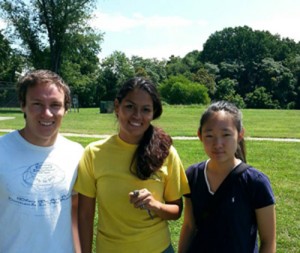Bioinformatics and Computational Biology
“How well do species tree methods deal with gene flow? The case of mitochondrial introgression in the northern oriole complex”

Although molecular data have generally improved our understanding of relationships among closely related bird species, most of these data come from a single gene region, mitochondrial DNA. Increasingly more cases of introgression, the case of gene flow between closely related species, are being documented in birds, particularly mitochondrial introgression. Even in studies that include nuclear data, nDNA sequences are frequently just combined with mtDNA (concatenated). However, given the high variability and informativeness of mtDNA, it is possible that mtDNA
We recently documented a case of mitochondrial introgression from the Baltimore Oriole lineage (Icterus galbula) into that of the Mexican Black-backed Oriole lineage (I. abeillei). Multiple methods for analyzing nuclear autosomes and Z-chromosomes, both separately and combined, all recover the traditional close relationship between I. abeillei (Black-backed) and I. bullockii (Bullock’s). However, simple concatenation of mtDNA and nDNA produces the mtDNA tree (Black-backed + Baltimore). Only when we artificially replicate the nDNA data six times is there enough signal in the nuclear data to overwhelm the misleading mitochondrial signal.
We are currently testing how well species tree algorithms including *BEAST (a coalescent based method) and BUCKy (a consensus based method) deal with introgressed gene regions, such as this example of highly incongruent mtDNA in the Northern Oriole group.
What research experiences have you had?
I have been a part of the Undergraduate Biology and Mathematics (UBM) training program since last December. For UBM, I work in Dr. Kevin Omland’s lab and focus on resolving phylogenetic trees using species tree algorithms and parallel computing. Also, within the Omland Lab, I assist other laboratory researchers by going out in the field to record and catch birds.
How did you find the research opportunity?
I actually found out about UBM through an email that Dr. Omland sent out! He was looking for a computational biology researcher to join the UBM program, and I jumped at the opportunity.
Who did you work with on this project?
I work with Tylynn Pettrey, who is an undergraduate and my partner in the UBM program. I also work with Dr. Omland, Dr. Matthias Gobbert in the Department of Mathematics and Statistics, and Dr. Frode Jacobsen in the Omland Lab.
Was this your first independent research project?
Yes it was!
Do you get course credit for this work? Paid? How much time do you put into it?
I do get course credit and I am paid. I put in between 8 and 12 hours a week during the semester.
What academic background did you have before you started?
I had a very diverse scientific background when I started in the lab. As a Bioinformatics major, I took courses in biology, computer science, chemistry, and mathematics – nearly all of the courses have paid off in some way or another.
How did you learn what you needed to know to be successful in this lab?
The biology and computer science courses I took were extraordinarily helpful in learning about my research topic and being able to implement the specific computer programs that I use. Also, the UBM program uses a mentor program in which older students “train” new members during their first semester on the project. My mentor, Leila Kazerooni, helped me learn more about the details of the project and taught me what I needed to know to become independent.
What was the hardest part about your research?
The hardest part is making everything work! I use many computer programs on a daily basis, and sometimes they do not all work the way I want. Solving the problems that subsequently arise is the most challenging part for me.
What was the most unexpected thing?
The most unexpected thing was the amount of traveling I have gotten to do. Within the last 5 months, I have gone to Puerto Rico, Chicago, and the Appalachian Mountains – all for research. When I first began work on my project, I had no idea that I would be able to go to all those places in the name of science. Being able to see and experience them has been the most unexpected reward my research has offered me.
What is your advice to other students about getting involved in research?
Don’t be afraid to put yourself out there! Professors are always looking for students who are interested and engaged, but the only way they can tell if you are interested is for you to make the first move.
What are your career goals?
Right now, I am focused on getting into graduate school and pursuing a doctorate. As of right now, I am unsure of a full-time career path, but I know I do enjoy evolutionary biology in general. I can certainly see myself in a career relating to that field sometime in the future.
What are you doing next for research?
For the next semester, I will be continuing to work in the Omland lab on my UBM project.
What else are you involved in on campus?
I am involved all over the place! I am the Vice President of the Honors College Council (and a member of the Honors College), part of the orientation team as a Woolie, as well as a teaching assistant for Cell Biology and a computer science tutor. I also play the viola in the UMBC Community Symphony Orchestra and swim for the newly founded Swim Club.
Have you shared the results of your work with professionals in the field?
Yes I have! I traveled to the American Ornithological Union Meeting in Chicago, Illinois this August to present my research to professionals in the field of ornithology. I also recently presented at the South Eastern Population, Ecology and Evolutionary Genetic (SEPEEG) Conference in Mountain Lake, Virginia to an audience of evolutionary biologists.
10/14/2013